
Student Projects
VE/VM450

Machine Learning in 5G Channel Estimation (ML5G) for Millimeter-Wave MIMO Systems
Instructors: Prof. Chong Han
Team Members: Zhengdong Hu, Zeyuan Liu, Hongming Bai, Tianyi Yang
Team Members: Zhengdong Hu, Zeyuan Liu, Hongming Bai, Tianyi Yang
Project Video
Team Members

Team Members:
Zhengdong Hu, Zeyuan Liu, Hongming Bai, Tianyi Yang
Instructors:
Prof. Chong Han
Project Description
Problem
5G communication has become a reality in recent years. However channel estimation is a challenging task in improving the performance of 5G communication, especially for millimeter-wave MIMO systems. Our project aims to apply machine learning to improve the accuracy and reduce overhead of channel estimation in 5G area.

Fig. 1 Millimeter wave MIMO system based on hybrid architecture [1]

Fig. 2 Scenario of channel estimation
Concept Generation
Given the dataset of channels, the received samples can be generated at the simulated MIMO architecture with different noise levels. The size of training set for every channel can vary. To tackle the problem of different size of training set, the training set should be normalized at first. To improve the accuracy, deep learning network should be designed to explore the time and frequency correlations

Fig. 3 General workflow of data
Design Description
The channel estimation model FCN-LSTM combines the strengths of two deep learning network, FCN (Fully Convolutional Network) and LSTM (Long Short Term Memory Network). FCN can allow the input of different sizes, which can normalize the input. LSTM can explore the time and frequency correlations between training samples. Combing this two kinds of networks, the model can accept training sets of arbitrary sizes, and achieve good performance in estimation accuracy.

Fig.4 The designed FCN-LSTM model
Modeling and Analysis
The deep learning network is developed in the environment of TensorFlow. The FCN is responsible for extracting the information from the irregular input into the intermediate result of fixed size. Then the intermediate result is dispatched to LSTM to find extra information to improve the accuracy. Finally, the model reshapes the results to output the estimated channel matrix.
Validation
Validation Process:
With the training data generated with SNR=-10dB, we set the loss function as MSE and the custom loss as NMSE for the model fit training process.
Validation Results:
With the training data generated with SNR=-10dB, we set the loss function as MSE and the custom loss as NMSE for the model fit training process.
Validation Results:
According to the table in engineering specifications, our model is qualified and well-performed. To better measure the efficiency, we conduct the comparison between our model FCN-LSTM and the benchmark SF-CNN. [2] Our model outperforms the benchmark with fewer epochs iterations and gets rid of the dependence on the related parameters that are required in SF-CNN.

Conclusion
The FCN-LSTM model can be used to estimate the channel from the training set of different sizes, and achieve good performance in accuracy, which can be further improved for real use.
Acknowledgement
Sponsor: Prof. Chong Han from UM-SJTU Joint Institute
Reference
[1]https://research.ece.ncsu.edu/ai5gchallenge/#datasets
[2]P. Dong, H. Zhang, G. Y. Li, I. S. Gaspar, and N. NaderiAlizadeh, “Deep CNN-Based Channel Estimation for mmWave Massive MIMO Systems,” IEEE J. Sel. Topics Signal Process., vol. 13, no. 5, pp. 989–1000, Jul. 2019.
UM-SJTU JOINT INSTITUTE